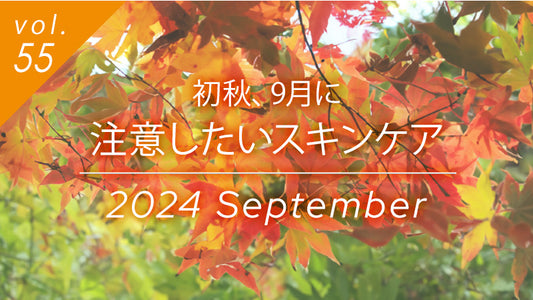
ようやく猛暑の夏も終わり、一気に秋が深まりつつある日々となってきました。北海道の大雪山系では紅葉が進み、これから日本全国へと紅葉前線が南下してきます。植物学的に紅葉を紐解いてみると、夏から秋への季節の移行時期のスキンケアへのヒントが詰まっています。今回は「10月の美容ライフへのヒント」についてお届けしたいと思います。
紅葉のメカニズム
2023年紅葉見頃予想
紅葉は気温変化、日照時間などがその時期や程度に密接に影響します。日本気象協会による今年の紅葉見頃予想によれば、9月の気温が全国的に平均より高くなり、傾向は10月も続くとの見込みから、今年の秋の紅葉の見頃は北日本は例年より遅く、東日本および西日本では例年並みか例年より遅くなると予想されています。

紅葉のメカニズム
紅葉にはポリフェノールの一種でもある「アントシアニン」という天然色素が深く関わっています。春から夏にかけては「クロロフィル(葉緑素)」と呼ばれる緑色の色素が作られ、日光をエネルギーとして、根からとり入れた水と空気中の二酸化炭素から、でんぷんを作るとともに、酸素を出すという植物ならではの光合成という機能を発揮しています。落葉樹の葉は、秋から冬に向かってクロロフィルの分解が進み、葉に蓄えられた栄養が幹に回収され、来春にその栄養が再利用されるとのことです。一方、秋にはアントシアンの産出へ移行し、アントシアニンの割合が高まることで葉は赤く色付いてゆきます。この過程でアントシアンは日光の害から植物を守り、冬の落葉樹の休眠期間を支える働きがあるとされています。
1日の最低気温が8℃を下回ると紅葉が進み、また、寒暖差が大きいとクロロフィルの分解が進み、紅葉の元とも言えるアントシアニンの生成が始まります。アントシアニンの生成には日光が必要であることから、日照も紅葉の条件の一つと言えます。つまり、最低気温8℃、寒暖差、日照が紅葉の3要素となります。
秋の行楽シーズンで紅葉を楽しむ際には、この紅葉のメカニズムを知り、ベストのタイミング・場所を探索されてはいかがでしょう。
紅葉から学ぶ秋本番のスキンケア
ヒトは冬眠はしませんが、肌も秋から冬にかけて肌代謝は衰えます。特に猛暑の夏を過ごした今年の肌は、夏肌ダメージが蓄積されている方も多く、紅葉が進むこの時期の寒暖差や減少し続ける湿度も相まって、乾燥がきっかけとなる肌トラブルが起こりやすい状態にあります。
植物がアントシアニンという色素の力で栄養を幹に蓄えるように、代謝が衰え乾燥が進む冬を乗り越えるために、肌に栄養を与えるとの発想でのスキンケアが秋本番のこの時期には大切です。つまり、降り注ぐ太陽光から肌を守りながら、潤いを与える保湿ケアを強化し、エイジングケア効能のある美容液でしっかり肌に栄養を補給してあげましょう。

美容の観点からの「抗酸化」
酸化とは?
酸化=老化です。化学工業の世界でも酸化防止剤=老化防止剤と呼ばれ、酸化による物質の劣化を防ぐ様々な添加剤が使用されています。酸素が化学結合することが酸化で、鉄が錆びる現象は酸素が結合して酸化鉄となった状態です。食品の場合では。酸化によって鮮度が落ち、品質・風味が損なわれるので、真空包装や脱酸素剤などにより食品の酸化を防いでいます。一方、大気中の約20%は酸素であり、ヒトを含む生物は酸素により生命活動を維持しています。酸素は必要不可欠なものでありながら老化や疾病の原因にもなるという悩ましいものです。
酸化ストレスと活性酸素
活性酸素という言葉を聞いたことがあるかと思います。呼吸により体内に取り込まれた酸素の約30%程度が反応性の高い活性酸素に変化し、細胞間伝達物質や免疫機能として働きます。活性酸素自体にはこのような大切な機能があるのですが、過剰な産出はカラダの酸化(=老化)や細胞を痛めたり、様々な疾患をもたらす要因となることから、活性酸素には悪者イメージが定着しています。体内には活性酸素を防御する機能もあるのですが、活性酸素の過剰な産出につながり、自ら持っている活性酸素防御機能を阻害してしまう酸化ストレスを理解し、酸化ストレスを軽減する美容ライフを送ることが重要です。酸化ストレスの原因としては、紫外線、放射線、大気汚染、たばこ、薬剤などの外的な刺激物質に加え、過度な運動や心因的ストレスも酸化ストレスを引き起こす要因となります。

食生活からの抗酸化美容ライフ
抗酸化を意識した美容ライフへ、まずは抗酸化作用のある食材の摂取がオススメです。実りの秋、食欲の秋ですので、食材に気を配った美容ライフに取り組んでみましょう。主なオススメの食材は次の通りです。
【ビタミンC】
緑黄色野菜(パプリカ・パセリ・ブロッコリー・青菜類など)、フルーツ(キウイフルーツ・いちご・かんきつ類など)
【ビタミンE】
植物油(ひまわり油・やし油・べに花油など)、種実類(ごま・アーモンド・ピーナッツなど)
【ポリフェノール類】
プルーン・りんご・赤ワイン・コーヒー・緑茶・紅茶など
【ミネラル類】
海藻類(わかめ・のり・昆布など)、魚介類(桜えび・うるめいわしなど)、納豆など
【カロテノイド】
緑黄色野菜やフルーツの黄色、オレンジ、赤色の色素成分。パプリカ、トマト、ホウレンソウ、ミカンなど
日ごろからバランスの取れた食事、適度な運動習慣ならびに十分な睡眠により抗酸化防御機構を良好に保ち、活性酸素の過剰な産出を抑制する美容ライフを送ることが重要となります。
「10月の美容ライフへのヒント」についてお届けしました!
次回のテーマは「冬への備えのエイジングケア」をお伝えします。



